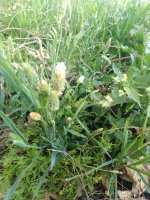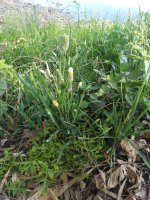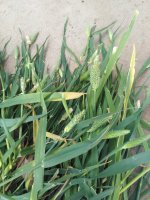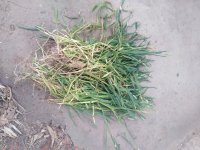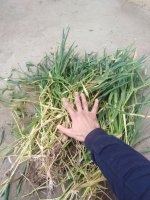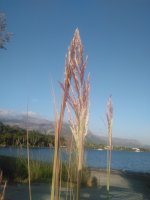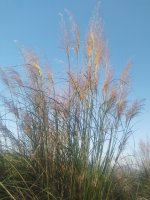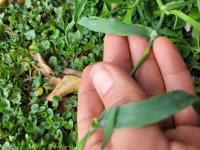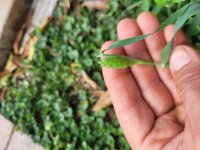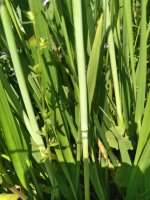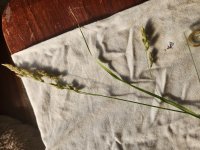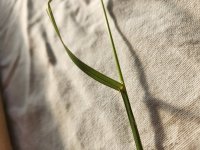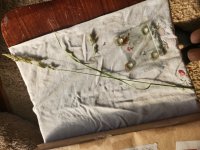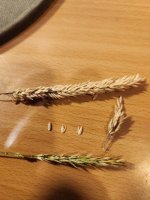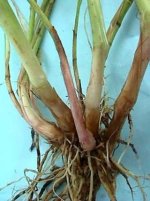-
Members of the previous forum can retrieve their temporary password here, (login and check your PM).
You are using an out of date browser. It may not display this or other websites correctly.
You should upgrade or use an alternative browser.
You should upgrade or use an alternative browser.
Phalaris/other grass types ID thread
- Thread starter zombicyckel
- Start date
Migrated topic.
A different kind of reed... Very common in the wider area. Strange that I couldn't find it's id on local flora papers. Anyone have an idea? Grows up to over 3m.
Attachments
neurobloom
Established member
I seen this species as an ornamental in roundabouts in my hometown city. Not a reed for sure.
It's wild and extremely common over here. I think the ornamental species you mention might be Cortaderia selloana. This is not that.
The sidewalk growing city Phalaris early bloomers have arrived here.
What is it? It should be minor.
(I shamefully admit that I never learned how to distinguish Phalaris aquatica and minor.)
My first ever Phalaris bioassay was with such a grass growing in a sidewalk and it was definitely DMT active.
What is it? It should be minor.
(I shamefully admit that I never learned how to distinguish Phalaris aquatica and minor.)
My first ever Phalaris bioassay was with such a grass growing in a sidewalk and it was definitely DMT active.
Attachments
neurobloom
Established member
It can't be aquatica if dosen't grow new shoots from underneath the soil right next to the original seedling. Can't be minor if it produces red sap when cutting the blades or stems either.. patterns on that panicle isn't anything like aquatica also...they are narrow patterns more lengthy than wide.. and they never change
Hello I have problem identifying is this plat Phalaris arundinacea. I found 2-3 diffrent looking plants. Can someone help me?
1. https://gaysense.xyz/789SrBIO
2. https://gaysense.xyz/72MGAXhD
3. https://gaysense.xyz/L6wzGFgx
4. https://gaysense.xyz/HIQM1hld
5. https://gaysense.xyz/K7zPA68J
6. https://gaysense.xyz/wil0Rl5g
7. https://gaysense.xyz/oO05x7Ko
8. https://gaysense.xyz/SIlfEUD2
9. https://gaysense.xyz/vFZN5Luf
1. https://gaysense.xyz/789SrBIO
2. https://gaysense.xyz/72MGAXhD
3. https://gaysense.xyz/L6wzGFgx
4. https://gaysense.xyz/HIQM1hld
5. https://gaysense.xyz/K7zPA68J
6. https://gaysense.xyz/wil0Rl5g
7. https://gaysense.xyz/oO05x7Ko
8. https://gaysense.xyz/SIlfEUD2
9. https://gaysense.xyz/vFZN5Luf
downwardsfromzero
Boundary condition
None of them looks like it to me. Merging this thread to the Phalaris ID thread.daa? said:Hello I have problem identifying is this plat Phalaris arundinacea. I found 2-3 diffrent looking plants. Can someone help me?
1. https://gaysense.xyz/789SrBIO
2. https://gaysense.xyz/72MGAXhD
3. https://gaysense.xyz/L6wzGFgx
4. https://gaysense.xyz/HIQM1hld
5. https://gaysense.xyz/K7zPA68J
6. https://gaysense.xyz/wil0Rl5g
7. https://gaysense.xyz/oO05x7Ko
8. https://gaysense.xyz/SIlfEUD2
9. https://gaysense.xyz/vFZN5Luf
neurobloom
Established member
Looks like aquatica but can't be 100% low resolution.
Edit: it's actually an aquatica I'm sure. There was too much light outside now I we it clear. I could tell by the stripes on the panicles and panicle shape
Edit: it's actually an aquatica I'm sure. There was too much light outside now I we it clear. I could tell by the stripes on the panicles and panicle shape
Nichrome
Rising Star
Ok great thank you. I see a lot of this around here. There are lots of different areas and lots of different phenotypes. I'll try to get some good pictures this year. I am just getting to know this species. I appreciate the help with this one as I was unsure.
This bunch is really skinny and tall compared to the others I've seen nearby which are typically shorter with less space between the nodes, and thicker, more robust, and almost bluish/glaucus leaf like how a healthy trichocereus cacti can often look.
This bunch is really skinny and tall compared to the others I've seen nearby which are typically shorter with less space between the nodes, and thicker, more robust, and almost bluish/glaucus leaf like how a healthy trichocereus cacti can often look.
neurobloom
Established member
Aquatica can change change colour from Dee blueish green to pale green depending on the time of season. Usually the darker blueish green is at the peak of the vegetative growth when the plant has plenty of energy reserves.
The more you harvest it the paler the green gets.
The more you harvest it the paler the green gets.
Iglepiggle666
Rising Star
downwardsfromzero
Boundary condition
Looks more like Holcus lanatus to me, or in any case not P arundinacea. Nor is it Festuca arundinacea, if we're going by the "other grasses" part of the thread title.Iglepiggle666 said:What do you guys think? Arundinacea?
Iglepiggle666
Rising Star
downwardsfromzero said:Looks more like Holcus lanatus to me, or in any case not P arundinacea. Nor is it Festuca arundinacea, if we're going by the "other grasses" part of the thread title.Iglepiggle666 said:What do you guys think? Arundinacea?
Cheers for the response. Turns out it's actually Dactylis glomerata. Think it was a bit dry so looked deceiving. See Pasture plant identification
downwardsfromzero
Boundary condition
Yeah, you've got it - that was what I would have said had I not brain-farted the other one. Dactylis glomerata had me fooled once too, hence I can recognise it if not necesarily remember its name correctly :lol: There's a thread about Holcus lanatus and that's why the name was stuck in my head.Iglepiggle666 said:downwardsfromzero said:Looks more like Holcus lanatus to me, or in any case not P arundinacea. Nor is it Festuca arundinacea, if we're going by the "other grasses" part of the thread title.Iglepiggle666 said:What do you guys think? Arundinacea?
Cheers for the response. Turns out it's actually Dactylis glomerata. Think it was a bit dry so looked deceiving. See Pasture plant identification
Iglepiggle666
Rising Star
Phalaris Aquatica (dried) and its spikelets (top) and Anthoxanthum odoratum (bottom). Not entirely sure though, feedback welcome. The Phalaris aquatica rhizomes should look something like the photo attached, which I will check tomorrow.
Edit: After having a look at the whole plant, Top photo is actually Holcus lanatus due to soft leaves and stem. *sigh*.
Edit: After having a look at the whole plant, Top photo is actually Holcus lanatus due to soft leaves and stem. *sigh*.
Attachments
Iglepiggle666
Rising Star
neurobloom
Established member
Yes that's the one!
Let us know if you need any help.
Let us know if you need any help.

